How to Prevent Limescale
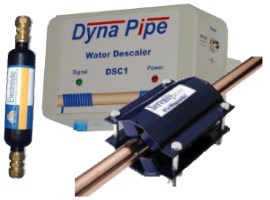 |
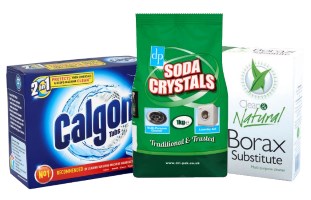 |
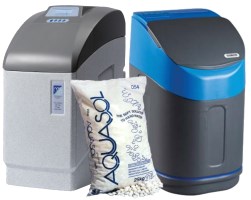 |
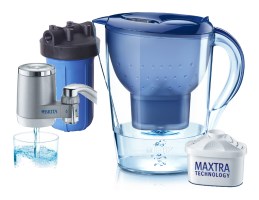 |
Physical Scale Inhibitors |
Chemical Water Conditioners |
Mechanical Water Softeners |
Water Filters |
Limescale prevention falls into one of the above categories. Within each of the four main groups there are a number of different devices that either inhibit or eliminate limescale. Below is a review of how each of the different types of water softener work, what they do, how they do it, and their advantages and disadvantages. Water distillers are classed as water purification systems but have been included at the bottom of the page because they do eliminate limescale.
Physical Water Conditioners
Physical Water Conditioners, so called because they physically alter the properties of hard water to reduce or eliminate limescale formation, come in three different types - electronic, electrolytic and magnetic.
Electronic Water Conditioners
What they are: Electronic water conditioners, also know as electronic descalers or limescale inhibitors, generally comprise of a small box of electronics and one or more coils wrapped around the pipework.
What they do: Electronic conditioners work by transmitting an audio frequency or radio frequency signal into the water via induction coils wrapped around the pipework. This inhibits the build up of limescale inside water pipes and through time, reduces existing scale. A softer scale may still form on showerheads, taps and other surfaces, but is much easier to clean.
Advantages: Electronic descalers are relatively cheap in comparison with other hard water treatment methods and offer a cost effective solution to limescale problems. No plumbing is required, making them very easy to install. And because nothing is removed or added to the water, healthy minerals are retained and the water remains safe to drink.
Disadvantages: Although sometimes not as effective as other treatment methods, most manufacturers offer a full money back guarantee if the device does not work as well as expected.
Buy a Dyna Pipe Water Descaler
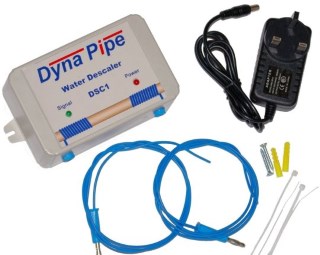
for only £79.95
Electrolytic Water Conditioners
What they are: Electrolytic water conditioners are inline devices that need to be plumbed into the water system. They can be bought with 15mm, 22mm, or 28mm end connectors to suit the pipework.
What they do: Inside an electrolytic conditioner are two dissimilar metals, normally copper and zinc, which act as a cathode and an anode. The electrolytic current that flows from the cathode to the anode causes small quantities of metal ions to dissolve into the water. The metal ions then disrupt the positively charged scale forming particles so that they don't clump together and form scale.
Advantages: Like electronic descalers, electrolytic scale inhibitors are relatively cheap to buy. They do not need an electric power supply and so annual running costs are zero. They provide whole house protection against limescale problems and treated water is safe to drink.
Disadvantages: Electrolytic water conditioners need to be periodically replaced to maintain the full level of protection and, unlike electronic conditioners, they need to be plumbed into the pipework, adding to the initial cost.
Electrolytic Water Conditioners
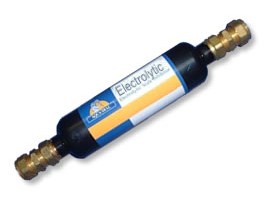
Electrolytic conditioners are inline devices that look similar to similar to the one shown above.
Magnetic Water Conditioners
What they are: Magnetic water conditioners come in two forms. They either clamp onto the outside of the pipework or are fitted inline with the pipework in the same way as electrolytic softeners.
What they do: Magnetic conditioners work in a similar way to electronic conditioners, but use a magnetic field rather than an electric field to alter the characteristics of the scale producing minerals in the water. Scale particles in the treated water lose their ability to adhere to one another and to pipes, boilers and other internal surfaces.
Advantages: Magnetic conditioners are fairly popular due to their relatively low cost. The clamping type is easy to fit and normally just needs tightening onto the pipework with a spanner. They do not need any electrical power and so running costs are zero.
Disadvantages: Magnetic conditioners are generally not suitable for whole house protection, only single appliances. Some magnetic conditioners need to be plumbed into the pipework and they all have to be replaced periodically to maintain full performance.
Magnetic Water Conditioners
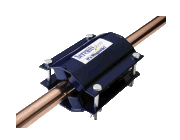
Magnetic conditioners come in a variety of shapes and sizes. Some are strap on devices while others are inline. Different manufactures use different magnetic materials and this can make a huge difference to the strength of the magnet.
Chemical Water Conditioners
Chemical water conditioners fall into two categories, packaged softeners and dosing systems. Packaged softeners can be further split into precipitating and non-precipitating types. The principal use of packaged softeners is to soften water for washing clothes
Precipitating Packaged Softeners
What they are: Precipitating packaged softeners include washing soda and borax. Although borax has a number of uses around the home, the main purpose of packaged softeners is for washing clothes and as such they are not suitable for whole house water softening and treated water is not fit to drink.
What they do: Precipitating softeners soften the water by combining with calcium and magnesium ions found in hard water. This causes the mineral ions to precipitate out, so that they don't interfere with the washing process.
Advantages: Cheap, easy to use softener that, in addition to softening, also cleans and deodorises. Adding borax or washing soda to the wash, will also prevent limescale build-up in the washing machine.
Disadvantages: Precipitating softeners make the water cloudy and can cling to materials in the wash. They also increase the alkalinity of the water, which can damage skin and some fabrics.
Precipitating Softeners
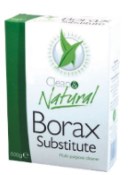
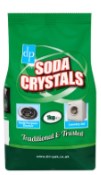
Non-Precipitating Softeners
What they are: Non-precipitating softeners include products such as calgon and are more commonly used than precipitating softeners. Like all packaged softeners, they are only intended for use in the laundry.
What they do: They work by using phosphates, which react with the calcium and magnesium ions in hard water and holds them in solution.
Advantages: As the name suggests, non-precipitating softeners do not form a precipitate and so the water remains clear. They do not increase the alkalinity of the water and so they're safe to use with all fabrics.
Disadvantages: Generally more expensive than precipitating softeners and not so eco friendly because of their high phosphate content.
Non-Precipitating Softeners
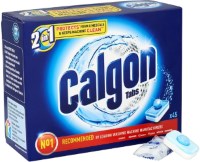
Phosphate Dosing Systems
What they are: Phosphate Dosing Systems comprise of a cartridge of phosphate held in a container that is fitted to the plumbing system. Water passing through the cartridge is dosed with small quantities of phosphate which softens the water.
What they do: Like non-precipitating softeners, they work by adding phosphates to the water. However, in dosing systems, food grade polyphosphates are used. The polyphosphates act as a sequester to stop the hardness minerals in hard water from precipitating out.
Advantages: Dosing systems typically cost in the region of £60 to buy, plus installation costs. Although generally only used for single appliance protection, they can provide whole house treatment.
Disadvantages: Most people prefer not to have phosphates in their drinking water, even if they are food grade safe. Replacement cartridges incur additional annual running costs of between £30 and £60.
Phosphate Dosing
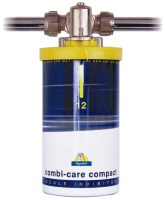
Phosphate dosing systems comprise of a filter housing into which a polyphosphate cartridge is fitted.
Mechanical Water Softeners
What they are: Mechanical Water Softeners, or ion exchange softeners as they are also know, are true water softeners. Physical and chemical conditioners, although sometimes referred to as 'softeners', do not remove hardness minerals from the water; they merely prevent them from precipitating out or from sticking to surfaces. The only true way to soften hard water is to remove the calcium and magnesium minerals that make it hard. Only ion exchange softeners, and some filter treatment methods, do this.
What they do: Ion exchange softeners work by swapping negative hardness ions in hard water with positive sodium atoms in a resin contained within the softener. Periodically, the resin needs to be regenerated to remove the build up of hardness minerals. This is done by flushing the resin with brine. During the regeneration process, household water is diverted around the softener and so only hard water is available. This is normally set to occur during the night. Alternatively, two resin tanks can be used, with one regenerating while the other is in service.
Advantages: Ion exchange softeners offer all the advantages of truly soft water for the whole house.
Disadvantages: The main drawbacks with ion exchange softeners are that they're expensive to buy, costly to run and can take up quite a bit of room (normally on the kitchen). A further drawback is that treated water contains sodium (salt). That said, they produce truly soft water and issues with sodium in the water can be resolved by leaving one outlet in the house untreated.
Water Softeners
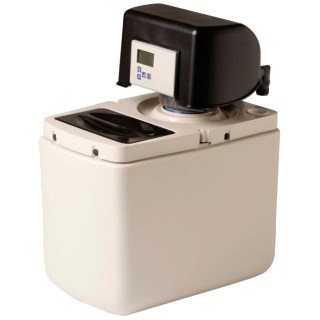
Water Filters
Water filters come in many shapes and guises from stand-alone jugs to fully integrated reverse osmosis units. The two most common types that will remove calcium and magnesium from hard water are, reverse osmosis units and carbon resin filters. There are many other types of filter available, but they do not remove hardness minerals.
Since filtered water is normally only available from a single outlet, water filters do not alleviate hard water problems throughout the rest of the home. Limescale deposits will still exist within the plumbing and heating system and on taps, showerheads and other surfaces. The exception to this, is reverse osmosis units which are suitable for whole house water treatment.
Carbon Resin Filters
What they are: Water Filter Taps and Water Filter Jugs use a carbon resin filter through which water is passed to soften it. With filter taps, the carbon resin is enclosed in a filter cartridge which is contained in a filter-housing and plumbed into the pipework. These inline filters generally only provide filtered water to a single outlet tap and because of this the filter and tap are often sold as an integrated water filter tap. The carbon resin in a water filter jug is normally contained in a disposable filter cartridge which is replaced as required.
What they do: Carbon resin filters use an ion exchange resin to remove hardness minerals from the water in a similar manner to mechanical water softeners. In filter jugs and in some filter taps, the softened water is then passed through an activated carbon (charcoal) filter to remove chlorine and other chemicals.
Advantages: When combined with an activated carbon filter, filter-jugs and inline cartridges produce pleasant tasting, relatively cheap, chlorine free, soft water. Where the carbon resin is used to produce a whole-house water softener, the resulting unit is much smaller than a conventional water softener, does not use electricity and is salt-free.
Disadvantages: Unlike mechanical water softeners, the ion exchange resin is not regenerated and builds up contaminants until it needs to be replaced. Whilst this is not too much of an issue with filter-taps and filter-jugs, carbon resin in whole-house water softeners can be very expensive to replace. Charcoal filters used in filter-taps and filter-jugs also needs periodic replacement and neither filter-taps nor jugs offer a practical solution to limescale problems elsewhere in the house.
Carbon Resin Filters
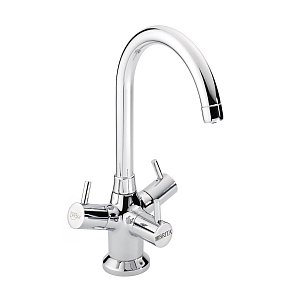
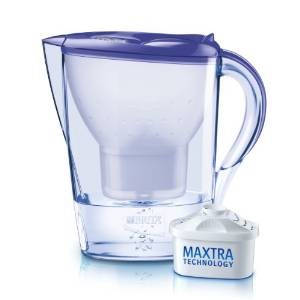
Carbon resin filters are used in both filter jugs and filter taps. After passing through the carbon resin filter, the softened water is often further filtered using active charcoal granules to remove chemicals, therby improving taste and eliminating odours.
Reverse Osmosis
What they are: Reverse Osmosis systems are perhaps the most popular type of filter for household water treatment. Whilst RO systems will remove calcium and magnesium ions from hard water, they are not normally installed purely for this purpose. Many homes with soft water have RO systems. Most home owners buy reverse osmosis systems to obtain cleaner, purer, water than is normally available from their water supplier.
What they do: Reverse osmosis filters work by forcing water through a semi-permeable membrane which filters out impurities. The membrane has microscopic holes through which water molecules can pass, but larger particles and molecules (like the hardness minerals) are blocked.
Advantages: In addition to effectively removing most contaminants, RO treated water tastes better, enhances the flavour of drinks like coffee, tea and fruit squashes. And in hard water areas, household appliances such as steam irons, coffee makers and kettles, will not suffer from the normal scaling.
Disadvantages: The main drawback with reverse osmosis units is that they use lots of water. Typical RO filter units purify only ten percent of the water that enters the system; the rest is piped to waste. This makes them unsuitable for whole house water treatment. Additionally, filter cartridges and the RO membrane require periodic cleaning / replacement (sometimes by a professional). Hard water also reduces the life of the RO membrane. With filter replacements typically costing between £150 and £700, they can also be expensive to maintain.
Reverse Osmosis
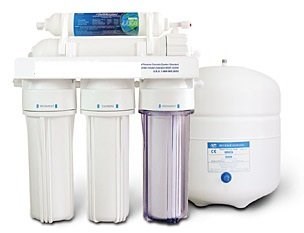
RO systems normally comprise of three or more filter units and a pressurised tank for storing treated water. Prefilters remove impurities that could damage the RO membrane used in the filter. Post filters remove any remaining tastes and odours.
Water Distillers
What they are: Water Distillers produce the purest water possible. Appliance for the home look like large kettles, while larger under-counter units are available for commercial premises and dental surgeries.
What they do: Distillers work by boiling water into steam, which then condenses back into water and is collected in a storage container. Impurities in the water are not converted into steam and so only pure water condenses into the storage container. Contaminants are left behind in the boiling chamber, which can then be cleaned with special crystals.
Advantages: Distillers offer the purest water money can buy. They have all the benefits of reverse osmosis filters plus a few others. The water they produce is purer than bottled water, always on tap and there are no heavy bottles to carry back from the supermarket.
Disadvantages: Distillation is not practical or economically viable for whole house water treatment, so limescale will still build up in pipes, boilers and heat exchangers as well as on taps, showerheads and other surfaces.
Water Distillers
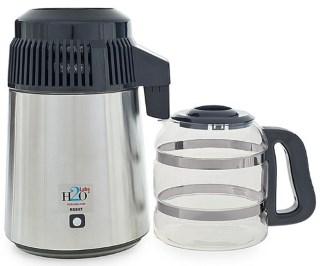
Water distillers comprise of a container similar to a kettle in which water is first boiled and then allowed to condense into a collection jug which sits beside the distilling unit.